 |
Christopher “Kit” CarsonMountain Man, Indian Agent, Military Officer, Explorer |
|
|
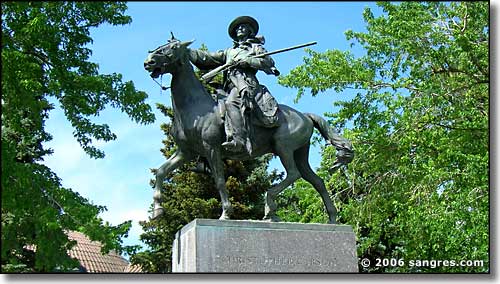 The Kit Carson Statue at Kit Carson Park in Trinidad, Colorado |
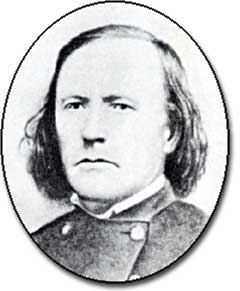
Kit Carson grew up on the Missouri border, watching his older brothers, one-by-one, disappearing up the Missouri River or over the Santa Fe Trail. After his father died in a field accident, his mother apprenticed him to a saddlemaker in Franklin. That life didn't suit him and in 1826, at the age of 16, Kit ran away and joined a wagon train bound for Santa Fe. (The saddlemaker reported him as a runaway and offered one penny as a reward to anyone who returned Kit to his place of business in Franklin.) After a bit of travelling around with the wagon trains, he showed up in Taos and took a job with a group of mountain men needing a helper. This led him into becoming a full-fledged fur trapper and for a dozen years he roamed all over the West, living by his traps, his rifle and his wits. In his later years he referred to this as the happiest time of his life. During this period he married Grass Singing, an Arapaho girl. They lived blissfully in a teepee and had a daughter, Adaline, and a son, Robert. During the spring hunt of 1841, young Robert fell into a kettle of boiling soap and died. Not long after, his mother, Grass Singing, contracted a fever and died, too. In the fall of 1841, Carson showed up at Bent's Fort on the Arkansas River and hired on as a hunter for $1 per day. While here he took another Indian wife, a Cheyenne named Making-Out-Road. This only lasted a few months before she divorced him in the accepted Indian way by tossing his saddle out the door of their buffalo-skin lodge (imagine the legal fees saved if this type of Common Law was practiced in modern America). In 1842 Kit travelled to Missouri and placed his daughter Adaline in a school there. On his way back to Bent's Fort, Kit met up with Lt. John C. Fremont who was preparing to begin a mapping and exploration expedition for the Army to the Rockies, and he needed a guide. As the Army paid much better than Bent, St. Vrain & Company, Carson jumped at the chance and, over the next several years, guided three of Fremont's expeditions throughout the West and was even with Fremont during the Bear Flag Revolt in California (1846). |
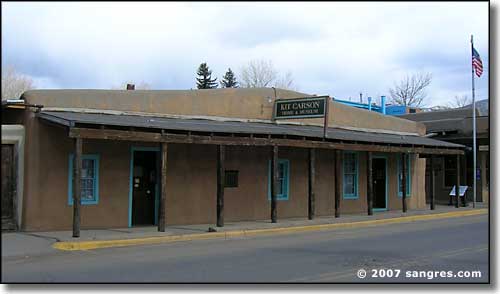 The Kit Carson Home and Museum in Taos |
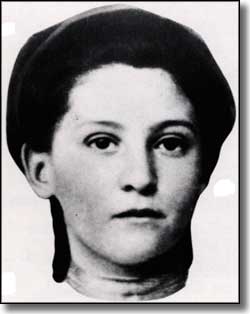 Josefa Jaramillo Carson, at age 18, 3 years after marrying Kit Carson Between the first and second Fremont expeditions, Kit drifted down to Taos where he meant to ask a fiery, bright-eyed young beauty named Josefa Jaramillo for her hand. Her family had problems with this. Carson was a 34 year old Anglo foreigner and Josefa was only in her mid-teens. Slowly, the Jaramillos were won over and the couple was wed. As a wedding gift, Kit gave Josefa the rambling adobe home in Taos that they lived in for the next twenty-some years. Today this home houses the Kit Carson Museum. They brought seven children into the world in that house, even though there were some problems caused by Kit's irregular income and his long absences from home when he worked as a guide. In 1854 Carson got a federal appointment as Indian Agent for the Utes and Jicarilla Apaches, a job that gave him a regular salary and allowed him to stay home much more. However, he was still called out regularly on Indian business. Once when he was away, a party of Utes stopped by his agency office. Josefa went out to speak with the heavily armed warriors who said they had business with "Father Keet," the name they used to address him. After telling the warriors that her husband wasn't there, she noticed a small Navajo boy sobbing on the saddle behind one of the Utes. When she asked about him she was told that after they were out of sight of the settlement, they were going to kill him because of his constant crying. Horrified, Josefa quickly asked them what they would accept as ransom for the boy. The Utes had a quick conference and replied that they would trade him for a strong, young horse. The trade was made. When Carson returned home a week later, one of the first things he noticed was the missing horse. When Josefa told him what had happened he accepted the boy gracefully and named him Juan Carson. Kit raised Juan as his own son and Juan remained with the Carson's until their deaths a decade later. In the fall of 1860, Kit went hunting with some friends in the San Juan Mountains of southern Colorado. On a steep trail his horse took a spill and Kit suffered serious internal injuries. He recovered but was left with recurring pain and physical damage that would eventually cost him his life. |
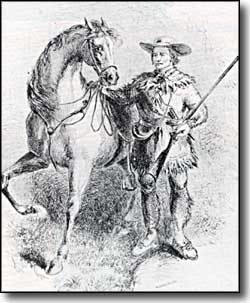
During the Civil War Kit resigned as Indian agent and took a commission as a Colonel in the New Mexico Volunteers at Fort Union. He was in the thick of the fighting in New Mexico until the Confederate army retreated in defeat back to Texas in 1862. Shortly after that, General James H. Carleton dispatched Kit on a campaign to defeat the Mescalero Apaches east of the Rio Grande. When he had accomplished that, Kit was then sent to subdue the Navajos of Arizona. This last assignment he tried to get out of but Carleton appealed to his strong sense of duty and patriotism and eventually talked Carson into it. Carson recruited a company of Ute scouts and marched west with his regiment. Through vigorous campaigning during the second half of 1863 he forced some 8,000 Navajos to surrender. The Navajos suffered about 50 casualties, mostly at the hands of their bitter enemies, the Utes. This was considered a remarkable military achievement because if anyone else had been in command, the Indian losses would have been much greater. Ironically, in recent years Kit Carson has been stigmatized as a wanton killer and brutal oppressor of Indians. In his day, he was regarded as an Indian lover. General Sherman once commented that the Indians trusted Kit Carson above all other white men, including the President. After carrying out several other military assignments, Kit was given command of Fort Garland at the foot of Mt. Blanca in southern Colorado. With a permanent station, Kit was able to bring up the wife and kids from Taos and lodge them in the commandant's house, a primitive log structure in the center of officer's row at the fort. His kids loved it, using the whole fort as their playground. While at the fort, Kit began to suffer serious after-effects of his horse accident in 1860: primarily chronic chest pain. He began to be worried about the future of his family. He applied for the higher-paying job of Superintendant of Indian Affairs for the Colorado Territory. |
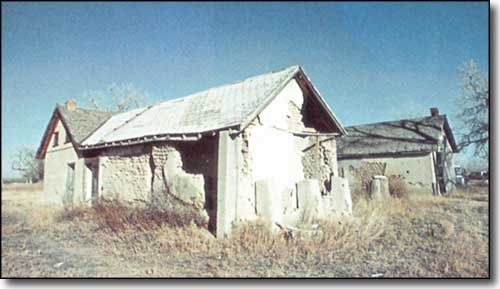 Boggsville, as it is now (although it is slowly being restored) |
 Josefa Carson and Kit Carson Jr., circa 1860 While waiting for that to come through, Kit decommissioned his New Mexico Volunteers, resigned his Army commission and moved his wife and family to Boggsville, near Las Animas, Colorado and close to Bent's Fort. He had friends there and hoped to get started in ranching. In January, 1868, the appointment as Indian Superintendant came through. A few weeks later he was asked to accompany a delegation of Utes to Washington for treaty negotiations. Josefa was pregnant with their last child and he was hurting but his sense of duty forced him to make the trip. Besides, he thought there might be a doctor in the East who could help him. After completing his Indian business in the capitol, Kit saw several doctors who all agreed that his case was incurable and that he actually might die at any moment. Kit rushed back to Josefa: by train to Cheyenne, stagecoach to Denver, and then in an open buckboard down the Front Range to Pueblo. At Pueblo he went to see Dr. Michael Beshoar. The doctor gave him some cherry cough syrup with opium and quickly examined him. He found an aneurism of the carotid artery, a bulge in the weakened artery wall big enough to see. At any time it could burst and Kit would die. In an even greater hurry, Kit descended 85 miles down the Arkansas River to Boggsville. Josefa heard he was coming, hitched up the wagon and rode out to meet him. Two days later she gave birth to Josefita (Josephine) and ten days later Josefa died from complications related to childbirth, a regular occurence in those days. Kit executed papers making Tom Boggs, his in-law, guardian of his children and Executor of his will. On May 14, Tom took Kit to Fort Lyon, north of Boggsville. There he was placed in the quarters of the post surgeon, Dr. H. R. Tilton. The doctor remained at his bedside until the afternoon of May 23, 1868 when Kit requested a buffalo steak. He ate the steak with relish and then called for his pipe. At 4:25 pm he uttered his last words: "Adios, compadre. Adios!" and died with blood gushing up his throat. |
|
|
 |
| Index - Arizona - Colorado - Idaho - Montana - Nevada - New Mexico - Utah - Wyoming National Forests - National Parks - Scenic Byways - Ski & Snowboard Areas - BLM Sites Wilderness Areas - National Wildlife Refuges - National Trails - Rural Life Sponsor Sangres.com - About Sangres.com - Privacy Policy - Accessibility |
| Most of the black-and-white photos and images are in the public domain. The photo of Josefa Carson and Kit Carson Jr. courtesy of Kit Carson Historic Museums. Color photos courtesy of Sangres.com, CCA ShareAlike 3.0 License. Text Copyright © by Sangres.com. All rights reserved. |